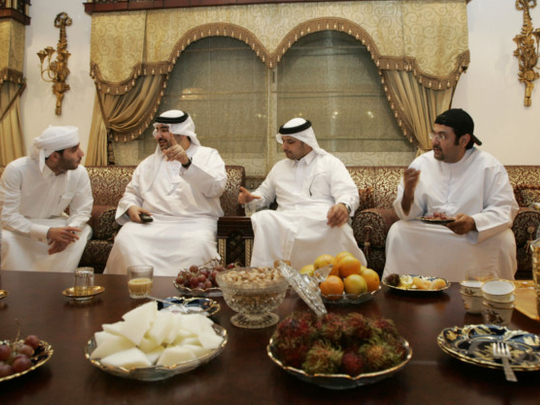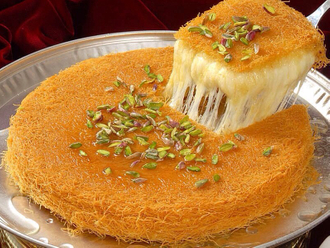
Dubai: Not only is Ramadan a month of spiritual and religious importance to Muslims, it is also a time that strengthens ties between family and friends, especially during iftar.
Just as Prophet Mohammad [PBUH] made it a habit to break his fast with dates and water, which Muslims follow as a sunnah or teachings, each household has its own traditions that are special to the holy month. Considering that food can be a unifying factor among people, we spoke to Gulf News readers to find out what traditional dishes are especially significant to their family’s Ramadan iftar.
For Wafa Derouiche, a Tunisian living in Dubai, her traditional dishes hold great importance to her as she lives away from her family. For her, enjoying iftar time with popular Tunisian dishes is a way for her to feel connected to her home.
She said: “The dishes I prepare during Ramadan, such as brik or chorba, are very Tunisian. Having these meals is a way for me to revive the connection to my country. I invite my friends, who are mostly non-Tunisians in the UAE, and introduce them to my culture. They enjoy it a lot.”
Derouiche explained that most of the Tunisian dishes are traditional recipes that have been passed down the generations in her family. Brik is a staple dish on “every true Tunisian table every day of Ramadan,” according to Darouiche.
Brik, similar to sambosas, are large triangular pieces of thin Tunisian dough filled with egg, tuna, parsley, potato and salt and pepper. It’s a dish usually eaten as an appetiser, especially during Ramadan because it is filling.
Another must-have traditional dish for Derouiche is chorba, or soup, which is what she breaks her fast with. One of the traditional chorba recipes she prepares includes orza pasta with pieces of lamb slowly cooked for over two hours.
In Tunisia, couscous is considered a dish of good fortune, which is why they cook it during Ramadan as well. “On the 14th night of Ramadan, or mid-Ramadan, and the 27th night of Ramadan, which are considered holy nights, we prepare couscous for good fortune,” she added.
Nutritious recipes from Grandma
Similar to Derouiche, 24-year-old Jumana Abdul Razzaq lives far from her family in Jordan. One dish that the Dubai-based Palestinian associates with Ramadan at home is her grandmother’s Qamar Al Deen pudding desert. It is made from pureed dried apricots and is usually used during Ramadan to make a popular and refreshing juice, but for this dessert it’s made into a paste and mixed with dates, nuts and fruits.
She said: “I remember my grandmother always making us this dish at home. Now, many members of my family, like my mother and aunts, make it regularly during Ramadan and Eid Al Fitr.”
While the dessert combines different snacks usually eaten during Ramadan, Abdul Razzaq considers traditions to be very important.
“Traditions bring a sense of comfort, home and familiarity. They are important in preserving the ties you have with your family and heritage,” she said.
Asma Mazhar, a Pakistani Dubai-based resident, also prepares a traditional dish called fruit chaat during Ramadan.
She said: “The recipe that I learned from my grandmother is so simple yet tasty. It is made from guava, banana and orange juice. Then we add ground black pepper, rock salt and sugar. These days we add pomegranate, grapes and a bit of chaat masala or mixed spices to add more flavour to it. This dish is common to India and Pakistan, and it has a strong nutritional value.”
Value of tradition
Ninteen-year-old Maria Asaad from Bahrain said that she enjoys a variety of traditional “Khaleeji” dishes during Ramadan more than any other month.
She said: “Every day we have a variety of foods, and we always try to make someone’s favourite dish. We have the usual khaleeji dishes likes samboosa, fareed, kunafa and harees.”
One traditional dish they usually have every day during Ramadan is Fareed, which is eaten with rice during the rest of the year.
“During Ramadan, fareed, a sauce-like dish, is eaten with bread to keep it lighter. It also includes some chicken and potato, but flavours can vary depending on preference. It’s a common dish in the Gulf, but it’s a typical Ramadan dish,” Asaad said.
For the Sharjah-based resident, her family considers dessert to be an important part of the meal.
“We’re into dessert at my house. It’s kind of like the happy ending of the meal and we usually have a caramel custard that my mum makes.”
Asaad considers her family traditions important because “they bring people together.”
She said: “Younger generations become familiar with dishes that the family makes, which is how they learn about our culture and carry on the tradition. Food brings people together; it represents our culture and speaks for us as well.”
On GNTV
Discover some of the traditional recipes and how they’re made








